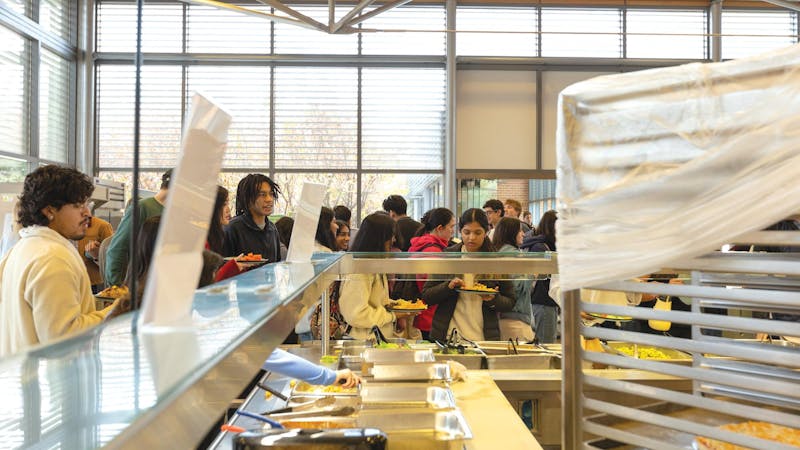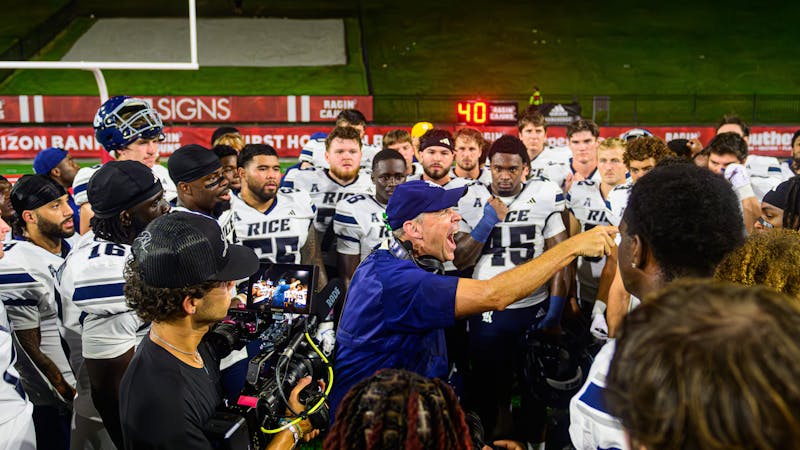Permeable concrete gets a break
After a series of trials and error, Facilities, Engineering and Planning staff may have stumbled upon the secret for its eco-friendly water-permeable concrete: Use the concrete in more lightly-traveled areas. After installing a test strip of concrete in the North Annex lot last year, FE&P workers have learned to mix the concrete off site and that the water-permeable concrete, which can be significantly more expensive than regular concrete, is not interchangeable with regular concrete. The first test patch of permeable concrete was installed in April 2007 on the future site of Duncan College. It has been used in the North Annex Parking Lot, on the walkway between Hanszen College and the Inner Loop, the Oshman Engineering Kitchen, and in front of the Ralph O'Connor House.
In addition to being less slippery during rainstorms, the concrete provides many environmental benefits: It can help get water and air to tree roots and allow water to drain underground to prevent runoff and flash floods. It can also reduce the amount of land Rice has to put aside for detention areas for runoff rainwater, which is a major concern in a rainy city like Houston. Due to flooding problems, the City of Houston's building codes require builders to provide half a cubic foot of detention area - green space - for every square foot of natural ground that is paved over or built on.
Using permeable concrete, Rice could build areas that were hybrid parking lots and detention areas, which would reduce the need for above-ground detention areas and open up more space to development on campus,
Rice Project Manager Bob Nguyen said. He said he hoped to be able to build such a space in the future.
"I'm hoping that one day we'll work with the City of Houston when building a parking lot," Nguyen said. "Instead of carving out a space for detention, this permeable concrete design will allow us to reduce or eliminate the required land for detention."
Though the more environmentally-friendly option, permeable concrete also has drawbacks. It is five times the cost of regular concrete, difficult to install and not as durable as regular concrete.
Since the first test patch, construction staff and contractors have adjusted to the new technology, learning lessons along the way, Sustainability Director Richard Johnson said.
"This was sort of an experiment on both sides," Johnson said.
Communications Manager for FE&P Susann Glenn said the department learned many lessons during its first test trials.
"We had to ... [get] used to the new technology, how to mix the concrete and how much water to use," Glenn said. "We learned that takes a longer time to cure than a regular sidewalk does, and that it's important to mix it on-site."
Some of these lessons were learned from issues with the permeable concrete sidewalk near Hanszen last fall. The sidewalk started to crumble and crack in places shortly after being installed. Glenn said these problems were a result of poor installation and that the concrete had not had enough time to dry.
Johnson said because of its lack of durability, permeable concrete is not always an option.
"It's not a one-size-fits-all application," Johnson said. "We're learning where to use it and where not to use it. If a sidewalk is going to have lots of cart traffic, and maybe a construction crane rolled onto it every now and then, it might not be the best choice to use the material because regular concrete may hold up a little better."
In some areas, it might be better to use a mix of both permeable and regular concrete, Johnson said.
"It's better to use [permeable] concrete in actual parking spaces than in the driveways around the parking lot," Johnson said. "There's lots of pivoting, turning and traffic on the driveways, so regular concrete is more appropriate."
Johnson said there are no current plans to further expand the use of water-permeable concrete.
Wiess College senior Jeremy Caves said he supports the idea of permeable concrete, particularly because of its environmental benefits.
"It reduces runoff, it allows natural systems to return, and its biggest advantage is that it reduces pollution from runoff because the water that picks up pollution can seep into the soil, where there are microbes to break it down," Caves said. "This makes the most sense in parking lots because as far as I understand oil can be broken down by microbes. Runoff water with pollution would otherwise eventually make its way out to Galveston Bay, which is one of the reasons why we have such high pollution levels there."
Some other sustainable, eco-friendly building practices have been applied to other construction projects on campus. According to Johnson, Duncan's construction will consume half the energy it would if no sustainable building techniques were applied.
"The result of it is savings in energy, savings in money and a reduced carbon footprint," Johnson said.
Wiess junior Alex Tseng also said decomposed granite used on some of the campus pathways is environmentally beneficial and adds an architectural touch.
"It absorbs water, preventing runoff from clogging up the storm drains," Tseng said.
More from The Rice Thresher

Over 1,000 students petition against new meal plan
When Konstantin Savvon opened the Housing and Dining email announcing the new unlimited meal plan, he was instantly concerned about the impact on off-campus students like himself.

Rice football wins season opener under new coach
For the first time since 2018, Rice football opened its season with a victory. Scott Abell was soaked with yellow Powerade following a 14-12 win on the road Saturday against the University of Louisiana at Lafayette, which won 10 games and made it to the Sun Belt Conference championship last season.

Acting like an athlete: Rice basketball alum takes on Broadway
Underneath Chadd Alexander’s Broadway costume, there’s ankle tape and wrist braces — same protective gear he wore as a walk-on basketball player at Rice, though now he’s performing eight shows a week in the ensemble of “Harry Potter and the Cursed Child” instead of running conditioning drills in Tudor Fieldhouse.

Please note All comments are eligible for publication by The Rice Thresher.